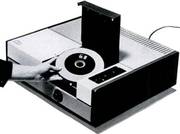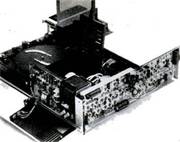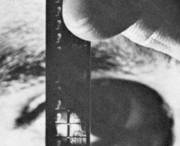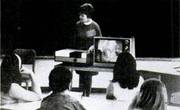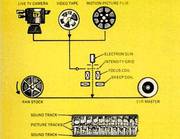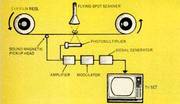Noch eine angeblich umwälzende Videotechnik aus 1969
Im Jahr 1969 wude vom dem CBS Präsident Dr. Peter Goldmark ein angeblich ebenfalls umwerfend neues Videoformat vorgestellt, der sogenannte EVR Film.
Wir haben in 2009 einen Prospekt aus Feb. 1970 mit den Visionen und den glorifizierten Daten und Möglichkeiten erhalten. Heute kennt dieses System fast niemand mehr.
Zu dem Bild oben stand (fast wie immer) folgender Text geschrieben:
EVR player is compact and simple to operate. Twin leads from player are clipped onto TV set's antenna terminals. After film cartridge (about size of a magnetic-tape reel) is placed on spindle, player starts with push of a button. Playing time is 52 minutes for each seven-inch reel. There are controls for fast-forward, rewind, slow-scan, and stop-motion display of any picture frame.
Im März 1969 schrieb ein Mr. Sam Shatavsky
"Electronic Video Recording" is the latest technological breakthrough for education and home entertainment
By SAM SHATAVSKY / Electronics Editor
A complete audio-visual entertainment and educational center in your home - that's what is coming with the introduction of CBS's new electronic video-recording system (EVR). Just as a long- playing record stores sound conveniently and inexpensively for later replay on a record player. EVR stores pictures and sound on a reel of film for playback through a standard television set. It is nothing like videotape recording.
EVR uses electron-beam imags recording on film to generate extremely small picture frames identical with those on movie film. The film is for playback only; you will not be able to make your own recordings, but will buy ready-made program reels produced by CBS and its licensees.
Any motion picture, videotape, or live television program can be commercially recorded for EVR playback.
The whole family benefits. An EVR cartridge is about the size of an ordinary seven-inch magnetic-tape reel. By simply inserting one into the playback machine, Daddy can sit at his TV set for an evening of golf lessons. Junior can bone up for a science exam with cartridges from the public library. Mother can take homemaking, bridge, or language courses. For entertainment, you'll have a choice of the latest movies, plays, and concerts. This will all come through your TV screen via the EVR player.
Because this new video recording system has a horizontal resolving power of up to 600 TV lines per picture frame, without interlace, picture quality is excellent.
EVR is also superior to magnetic videotape because of its high-speed low-cost duplication und the low cost of the film. It is predicted that cartridges will sell at the same price level as records with about the same playing time. Low film speed (six inches per second) gives fewer transport-mechanism problems — another advantage over the high-speed videotape machines.
CBS is setting up a plant for high-speed duplication and will develop the EVR market through the television, publishing and motion-picture industries. In license agreements with CBS, Motorola will manufacture EVR players and the New York Times will develop educational EVR cartridges.
Although introduced in black-and-white, EVR will ultimately go to color. The initial price of a player is estimated at $800.-, but without question, this new sight-and-sound recording and playback system promises to open new doors to gaining knowledge and enjoying entertainment at home.
Anmerkung der Redaktion:
Wie immer wurde viel versprochen, nur wenig wurde realisiert. Das Farbsystem kam auch nie auf den Markt, denn die Entwicklung wurde eingestellt, als kein Geld (mehr?) rein kam. Eigentlich wollten alle Mitmacher nur verdienen und die Arbeit sollten immer Andere machen. Das Lizenzsystem war undurchsichtig und verworren und für Europäer schon gar nicht zu verstehen.
Electronic Video Recording (EVR) How it works :
The electron-beam master recorder
Master film images are generated from an electron beam whose intensity varies with signals coming from the picture source. As explained by Dr. Peter C. Goldmark, president of CSS Laboratories, who headed EVR's development, "Because electron beams can be brought to a much sharper focus than light, the picture frame can be extremely small and still maintain excellent image resolution."
Each frame is swept with 525 beam lines - the standard TV horizontal sweep rate, providing compatibility for playback through standard TV sets. The format is two picture tracks with a magnetic sound track for each on the film's outer edges. Film width is .344 inches.
The high-speed duplicator
A 20 minute program can be printed in 30 seconds by multiple printer. Extra-wide eight-track raw film stock is slit to two-track EVR format. Magnetically recorded sound-on-film, synchronized with picture, is then added. Just as success of phonograph records depended on ability to cheaply produce copies, EVRs success will depend on low-cost film duplication.
The EVR player
Photographic information an film is translated into electrical signals with flying-spot scanner and photo-multiplier. Signal, amplified and modulating radio-frequency carrier, is fed to TV set through antenna terminals. Sweep rate of 525 lines per frame, together with appropriate light-beam synchronizing pulses coming from sync windows in film, locks in TV set's internal sweep generators for display of reproduced picture. Sound is reproduced by magnetic heads reading recorded tracks on film running at a rate of six inches per second.
Kommentar der Redaktion:
Ein zwar ausführlicher, aber für diese verwöhnte Zeit um 1970 bereits "sehr nüchterner" schwarz weiß Prospekt, besser eine Broschüre, und dann noch in englischer Sprache, die konnte hier in Deutschland keinen Stein mehr gewinnen. Das Maß der Dinge war die farbenprächtige deutsche Grundig Revue aus Fürth.
Doch auch Max Grundig konnte alleine mit bunten Bildern selbst als einer der sehr Großen der Branche in Eigenregie keinen Markt umwälzen und jedes beliebige Produkt dort "reindrücken". Sein C100 Audio- Kassettensystem scheiterte wie auch das VCR und Video 2000 System. Den schwarz weiß Prospekt über das EVR System finden Sie hier.
.

